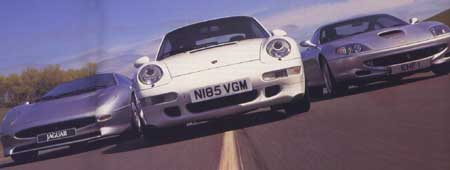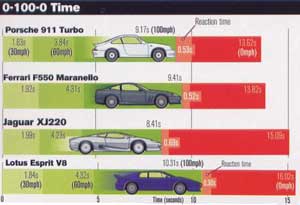

0-100-0
Supercars
Autocar Magazine, 1996
by Stephen Sutcliffe
The supercar showdown might have been a foregone conclusion had the Jaguar's front right tyre not gone badly flat, spotted by its owner while in the throes of a 'warm-up' run. After that, you could have got a Sainsbury's shopping trolley loaded with lead to stop faster than we could get the crippled XJ220 to.
The left the main duel to two of the oldest adversaries in the business: Porsche versus Ferrari, a head-to-head that's been raging ever since the first 911 took chunks out of a 246 Dino back in the late '60s. However, at no time in history has the battle been as ferocious or hard-hitting as it is here. The 911 Turbo squares up to the 550 toting an ominous blend of 408bhp, 398lb ft, twin K-16 turbochargers, six forward gears and a super-sophisticated four-wheel drive system – not to mention Porsche's latest Generation Five anti-lock system, which is so clever it will allow a wheel to lock momentarily if the surface is grippy enough.
But then you lift the Ferrari's extravagant bonnet and take a peek at what lies within. Suddenly, the mighty 911 no longer seems so intimidating, because the Ferrari boasts one of the most powerful and beautiful production engines in the world: a 48-valve quad-cam V12 of 5.5-litres which, thanks to Bosch 5.2 Montronic ignition and a compression ratio of 10.8:1, serves up a luxurious 479bhp at 7000rpm and 419lb ft at 5000rpm. To deploy this the 550 uses a bespoke six-speed manual gearbox and a limited slip differential with two different traction control mechanisms: one that works on the brakes, the other the throttle.
Alongside these two, even the 542bhp, 211mph, £170,000 Jaguar XJ220 no longer seems as outrageous as it once did. Then again, maybe it does.
And so we lined them up, side by side, to see which one went fastest. Initially, there wasn't any point even looking at the statistics. The all-wheel-drive 911 squatted dramatically, chirruped its rear tyres momentarily and screamed into the distance, leaving the Ferrari spinning its rear wheels aimlessly over the first few feet with the power-sapping ASR turned off, and the Jaguar struggling to balance off-boost lethargy with on-boost rear tyre meltdown. The 911 catapulted itself to 30mph in a gut-wrenching 1.63sec, the same time we recorded for the McLaren F1 a few years ago. Against it the 550 (1.92sec) and Jaguar (1.99sec) appeared to be walking away from the line. Rifling up the Porsche's gearbox is a piece of cake for anyone with a driving licence, in contrast with the heavy, ponderous shift of the Jaguar and the deliciously mechanical feeling (but slower) gearchange of the Ferrari. The 911 maintained its crushing lead up to 60mph (3.84sec versus 4.31 for the 550 and 4.23 fro the Jaguar), but from here on it became a power thing. Although the 550 failed to overtake the 911 by the time 100mph appeared, it got close , pulling back a couple of tenths on the Porsche and ducking under the tape in 9.41sec, versus the 911's 9.17sec.
Not that either of them could see which way the Jag had gone at this point, for the 220's gigantic swell of mid-range acceleration had reached a fearsome peak and rushed it to the ton in a scant 8.41sec.
But even if the 220's brakes and tyres had been functioning perfectly, I seriously doubt that it would have beaten either the Porsche or the Ferrari on the day. Between them these two represent the sharpest end of contemporary road car brakes. The most stunning thing for me is that the Ferrari managed to outbrake the Porsche by a whisker, despite carrying an extra 186kg of kerb weight. Not by enough to make it fastest outright; the 911 gets to 100mph just a shade too quickly for the 550 to be able to make up the difference under brakes. But the fact that the Maranello stopped faster than the Turbo at all had to be seen to be believed.
The gap was almost watertight when we'd finished doing the sums, the 911 sneaking inside the 550 by just two short tenths – 13.62sec verses 13.82sec.
All that the off-form 220 could do against this amazing display was to pick up the pieces back on 15.09sec.
Lotus positions low-cost alternative
You don't have to have a cool £100,000-150,000 rattling around in your bank account to secure the services of a supercar which can sprint from 0-100-0 in the blink of an eye, and the £60,000 Lotus Esprit V8 is the proof.This car's pace was so shattering when we road tested it last year that we wanted to include it in the main competition. In the end, we couldn't bring ourselves to subject it to the onslaught of the XJ220, 911 Turbo and Ferrari 550; but as things turned out, it would have been far from disgraced.
Esprits have always got off the line well, and the 349bhp twin-turbo V8 is no exception. Dial in around 5000rpm, let the clutch out smartly, and after a short patch of initial wheelspin it rockets to 30mph in 1.84sec and reaches 60mph, after a single gearchange, in 4.32sec. Six seconds and another two heaves on the ponderous gear lever and you're doing 100mph (10.31sec), at which point the Lotus is still well in touch with the Porsche and Ferrari. It is under brakes where it falters. Compared with the others (apart from the flat-spotted Jag), its 100-0 time of 5.71sec is well off the pace, the anti-lock triggering too early and too violently for a good result. Considering the weight advantage the 1346kg Esprit holds over the 911 and 550, this is disappointing. But for a third of the price we could just about live with it!

|
|